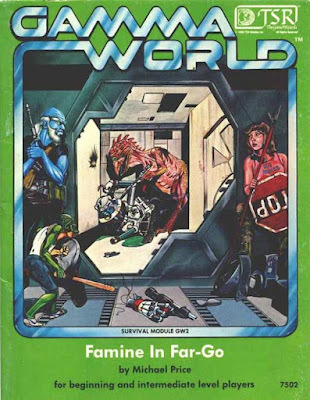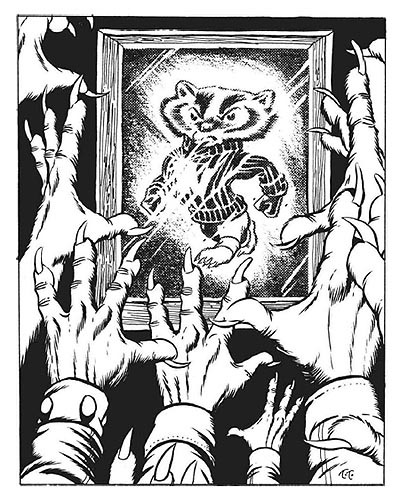The Setting of Gamma World (Part IV)
 The second – and last – product TSR published for the first edition of Gamma World is 1982's Famine in Far-Go. Written by Michael Price, the module was written "as an introductory adventure" and "to aid the GM in starting an ongoing GAMMA WORLD™ science fantasy game campaign." From that perspective, I'd say it's a qualified success – qualified, because it both leans heavily into the "primitive barbarians roaming the wasteland" version of Gamma World and because it's littered with lots of details that undermine the idea that the game's setting is centuries into our future.
The second – and last – product TSR published for the first edition of Gamma World is 1982's Famine in Far-Go. Written by Michael Price, the module was written "as an introductory adventure" and "to aid the GM in starting an ongoing GAMMA WORLD™ science fantasy game campaign." From that perspective, I'd say it's a qualified success – qualified, because it both leans heavily into the "primitive barbarians roaming the wasteland" version of Gamma World and because it's littered with lots of details that undermine the idea that the game's setting is centuries into our future.As a brief aside, I wanted to mention that, when I first got this module, I assumed – mistakenly, as it turns out – that the Far-Go of the title was not the most populous city in North Dakota. Having recently looked at a map of the region, it's now clear that it is. In my vague defense, the module's background section that the settlement of Far-Go is so named "in memory of [the] long and dangerous trek" made by its first inhabitants to reach its present location. This is, however, a just-so story and Far-Go really does seem to be Fargo, North Dakota. Go figure.
Now that I mention it, the location of Famine in Far-Go is relevant to the subject at hand. Here's the players' map included in with the module:
 I'm not sure that it's easily visible in the image above, but there are three "old high-speed roadways used by the Ancients," called "the Great Oad," "the 10," and "the 94." These are, respectively, Interstate 29, US Route 10, and Interstate 94. As depicted on the map, these roads all look like typical 20th century asphalt-covered highways with painted median strips. They're also (more or less) in the exact same locations that they occupied in the early 1980s. The Gamma World rulebook does state that, while "most roads ... have been destroyed ... some portions of a vast highway system for air-cushioned vehicles (similar to our interstate highway system) remain due to the incredibly tough duralloy metal from which it was constructed." No mention of this construction is mentioned in Famine in Far-Go, but if one is charitable, one could interpret its silence on the matter as consonant with the rulebook's statement. Still, the near-identity of the 20th century arrangement to that of the 24th seems implausible to me.
I'm not sure that it's easily visible in the image above, but there are three "old high-speed roadways used by the Ancients," called "the Great Oad," "the 10," and "the 94." These are, respectively, Interstate 29, US Route 10, and Interstate 94. As depicted on the map, these roads all look like typical 20th century asphalt-covered highways with painted median strips. They're also (more or less) in the exact same locations that they occupied in the early 1980s. The Gamma World rulebook does state that, while "most roads ... have been destroyed ... some portions of a vast highway system for air-cushioned vehicles (similar to our interstate highway system) remain due to the incredibly tough duralloy metal from which it was constructed." No mention of this construction is mentioned in Famine in Far-Go, but if one is charitable, one could interpret its silence on the matter as consonant with the rulebook's statement. Still, the near-identity of the 20th century arrangement to that of the 24th seems implausible to me.A bigger issue with the module is the presence of a large number of 20th century in-jokes and meta-humor among the treasures found in it. For example, the very first detailed encountered includes "an old, thin, damaged plastifax book" whose cover is torn so that "the only word that remains of the title is 'GAMMA.'" Moreover, inside the book is "a small plastic card" that "bears the hologram of a bearded man in pre-holocaust clothing. Below the picture is the inscription, 'Executive Pass, E.G.G., Pres.'" There's a GM Note after all of this that says, in relation to the book that "this item can be an amusing one if you have the desire to make it so." In another early encounter, the characters come across "an experimental counter-intelligence mechanism developed by certain Eastern European countries just before the onset of the great holocaust." The item bears three letters on it, "DDR," which I can only assume are the initials of Deutsche Demokratische Republik, which is to say, Communist East Germany. Once again, we have an out of place 20th century reference that makes little sense in Gamma World's future setting.
Then, there's this:
 For those of you unfamiliar with American collegiate sports, that's Buckingham "Bucky" Badger, the mascot of the University of Wisconsin-Madison. In the Timothy Truman illustration above, he's being adored as a deity by Badders, the mutant badgers of the game setting. I must admit that I chuckled when I saw this, but it seems more like something from Jack Kirby's Kamandi comics than the setting described in Gamma World. Mind you, American universities take their sports very seriously, so maybe they'll retain their mascots unchanged hundreds of years into the future. On the other hand, the Badders' warren also includes the wreck of "1995 model Lincoln Continental Mark IX car," which doesn't seem like something that should still be around after centuries.
For those of you unfamiliar with American collegiate sports, that's Buckingham "Bucky" Badger, the mascot of the University of Wisconsin-Madison. In the Timothy Truman illustration above, he's being adored as a deity by Badders, the mutant badgers of the game setting. I must admit that I chuckled when I saw this, but it seems more like something from Jack Kirby's Kamandi comics than the setting described in Gamma World. Mind you, American universities take their sports very seriously, so maybe they'll retain their mascots unchanged hundreds of years into the future. On the other hand, the Badders' warren also includes the wreck of "1995 model Lincoln Continental Mark IX car," which doesn't seem like something that should still be around after centuries.The central location of Famine in Far-Go is the La Prix Industries Automated Chicken Processing Factory. For the most part, the description of the factory is much more in keeping with the 25th century setting of Gamma World. The facility is filled with computers and a few robots, in addition to a nuclear power station. Now inhabited by mutant chickens descended from those originally housed here for poultry, the place is a decent example of what the GW rulebook calls a "mech-land" or robot farm. Of course, there are still a couple of in-jokes and 20th century references, like the presence of the book Animal Farm and "a magazine called Best of DRAGON™ Vol. 53."
Famine in Far-Go is thus another mixed bag when it comes to fleshing out the setting of Gamma World. The module mostly sticks to the script laid down in the first edition rulebook, but it still contains an inordinate number of references to things from the 20th century that simply don't make sense. My feeling is that this represents less a failure of imagination on the part of the writer – though that likely does play a role – and more a desire to include elements the players will recognize while their characters will not. I'm not at all opposed to that, nor do I think situational humor is necessarily inappropriate in a post-apocalyptic setting. Rather, I simply wish these elements were more clever, or at least less obvious. However, this is a constant issue with Gamma World products and not at all unique to Famine in Far-Go.
Published on April 11, 2023 10:00
No comments have been added yet.
James Maliszewski's Blog
- James Maliszewski's profile
- 3 followers
James Maliszewski isn't a Goodreads Author
(yet),
but they
do have a blog,
so here are some recent posts imported from
their feed.



